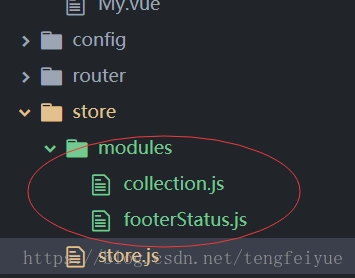什么是vuex,官网的描述是:Vuex 是一个专为 Vue.js 应用程序开发的状态管理模式。
状态管理模式包含3个部分:
1、state,驱动应用的数据源;
2、view,以声明方式将state映射到视图;
3、actions,响应在view上的用户输入导致的状态变化。
接下来说说它们是如何工作的。
首先说说如何在项目中使用vuex
首先安装vuex:npm install vuex --save
然后 在src文件目录下新建一个名为store的文件夹,并在store文件夹里新建一个index.js,里面的内容如下
import Vue from 'vue'; import Vuex from 'vuex'; Vue.use(Vuex); //使用vuex const store = new Vuex.Store(); //定义store export default store; //暴露store接口
接着,在项目的 main.js里面引入store,然后再全局注入一下
import store from './store'//引入store new Vue({ el: '#app', router, store,//使用store,即全局注入 template: '<App/>', components: { App } })
这样就可以在任何一个组件里面使用this.$store了。
搭建好vuex后,开始进入正题,如何使用vuex。
回到store文件的index.js里面,声明一个state变量,并赋值一个对象给它,对象里面随便定义两个初始属性值;然后再在实例化的Vuex.Store里面传入一个空对象,并把刚声明的变量state仍里面:
import Vue from 'vue'; import Vuex from 'vuex'; Vue.use(Vuex); const state={//要设置的全局访问的state对象 showFooter: true, changableNum:0 //要设置的初始属性值 }; const store = new Vuex.Store({ state //把上面声明的state对象扔到实例化的Vuex.Store里 }); export default store;
至此,你就可以在任何一个组件里,通过this.$store.state.showFooter或this.$store.state.changebleNum获取showfooter和changebleNum定义的值了。
but这不是理想的获取方式。
vuex官方API提供了一个getters,来实时监听state值的变化(最新状态),照样在store文件的index.js里面修改,具体看下面:
import Vue from 'vue'; import Vuex from 'vuex'; Vue.use(Vuex); const state={ //要设置的全局访问的state对象 showFooter: true, changableNum:0 //要设置的初始属性值 }; const getters = { //实时监听state值的变化(最新状态) isShow(state) { //方法名随意,主要是来承载变化的showFooter的值 return state.showFooter }, getChangedNum(){ //方法名随意,主要是用来承载变化的changableNum的值 return state.changebleNum } }; const store = new Vuex.Store({ state, getters }); export default store;
getters 只用来监听(获取)state的值,并不能用来改变state的值。改变state的值需要用mutations。照样在store文件的index.js里面修改,具体代码如下:
import Vue from 'vue'; import Vuex from 'vuex'; Vue.use(Vuex); const state={ //要设置的全局访问的state对象 showFooter: true, changableNum:0 //要设置的初始属性值 }; const getters = { //实时监听state值的变化(最新状态) isShow(state) { //承载变化的showFooter的值 return state.showFooter }, getChangedNum(){ //承载变化的changebleNum的值 return state.changableNum } }; const mutations = { show(state) { //自定义改变state初始值的方法,这里面的参数除了state之外还可以再传额外的参数(变量或对象); state.showFooter = true; }, hide(state) { //同上 state.showFooter = false; }, newNum(state,sum){ //同上,这里面的参数除了state之外还传了需要增加的值sum state.changableNum+=sum; } }; const store = new Vuex.Store({ state, getters, mutations }); export default store;
mutattions也是一个对象,这个对象里面可以创建改变state的初始值的方法,方法里面的参数用state或者额外的参数,
定义好之后同样把mutations扔进Vuex.Store里面。
这时候就完全可以用 this.$store.commit('show') 或 this.$store.commit('hide') 以及 this.$store.commit('newNum',6)
在别的组件里面进行改变showfooter和changebleNum的值了,
但这不是理想的改变值的方式。
因为在 Vuex 中,mutations里面的方法都是同步事务,意思就是说:
比如这里的一个this.$store.commit('newNum',sum)方法,每个组件里用执行得到的值,每次都是一样的,这样肯定不是理想的需求。
vuex官方API还提供了一个actions,这个actions也是个对象变量,最大的作用就是里面的Action方法 可以包含任意异步操作,
这里面的方法是用来异步触发mutations里面的方法,actions里面自定义的函数接收一个context参数和要变化的形参,
context与store实例具有相同的方法和属性,所以它可以执行context.commit(' '),然后把actions也扔进Vuex.Store里面:
照样在store文件的index.js里面修改,具体代码如下:
import Vue from 'vue'; import Vuex from 'vuex'; Vue.use(Vuex); const state={ //要设置的全局访问的state对象 showFooter: true, changableNum:0 //要设置的初始属性值 }; const getters = { //实时监听state值的变化(最新状态) isShow(state) { //承载变化的showFooter的值 return state.showFooter }, getChangedNum(){ //承载变化的changebleNum的值 return state.changableNum } }; const mutations = { show(state) { //自定义改变state初始值的方法,这里面的参数除了state之外还可以再传额外的参数(变量或对象); state.showFooter = true; }, hide(state) { //同上 state.showFooter = false; }, newNum(state,sum){ //同上,这里面的参数除了state之外还传了需要增加的值sum state.changableNum+=sum; } }; const actions = { hideFooter(context) { //自定义触发mutations里函数的方法,context与store 实例具有相同方法和属性 context.commit('hide');//commit里面的参数即为mutations对象里面的方法 }, showFooter(context) { //同上注释 context.commit('show');//同上注释 }, getNewNum(context,num){ //同上注释,num为要变化的形参 context.commit('newNum',num)//同上注释 } }; const store = new Vuex.Store({ state, getters, mutations, actions }); export default store;
而在外部组件里进行全局执行actions里面方法的时候,你只需要用执行this.$store.dispatch('hideFooter')或this.$store.dispatch('showFooter')以及this.$store.dispatch('getNewNum',6) //6要变化的实参。
这样就可以全局改变改变showfooter或changebleNum的值了。
如下面的组件中,需求是跳转组件页面后,根据当前所在的路由页面进行隐藏或显示页面底部的tabs选项卡
<template>
<div id="app">
<router-view/>
<FooterBar v-if="isShow" />
</div>
</template>
<script>
import FooterBar from '@/components/common/FooterBar'
import config from './config/index'
export default {
name: 'App',
components:{
FooterBar:FooterBar
},
data(){
return {
}
},
computed:{
isShow(){
return this.$store.getters.isShow;
}
},
watch:{
$route(to,from){ //跳转组件页面后,监听路由参数中对应的当前页面以及上一个页面
console.log(to)
if(to.name=='book'||to.name=='my'){ // to.name来获取当前所显示的页面,从而控制该显示或隐藏footerBar组件
this.$store.dispatch('showFooter') // 利用派发全局state.showFooter的值来控制
}else{
this.$store.dispatch('hideFooter') }
}
</script>
至此就可以做到一呼百应的全局响应状态改变了!
modules 模块化 以及 组件中引入 mapGetters、mapActions 和 mapStates的使用
在实际项目中,很多时候需要模块管理,比如写一个商城项目,你
所用到的全局state可能是关于购物车这一块儿的也有可能是关于商品价格这一块儿的;像这样的情况我们就要考虑使用vuex
中的 modules 模块化了,具体怎么使用modules呢?咱们继续一步一步的走:
首先,在store文件夹下面新建一个modules文件夹,在modules文件夹里面建立需要管理状态的js文件,不同的状态需要用不同的js文件来管理,如下图:

在store文件夹下面的index.js 里面引入这两个文件,内容改写成:
import Vue from 'vue'; import Vuex from 'vuex'; import footerStatus from './modules/footerStatus' import collection from './modules/collection' Vue.use(Vuex); export default new Vuex.Store({ modules:{ footerStatus, collection } });
相应的js文件如下:
//collection.js const state={ collects:[], //初始化一个colects数组 }; const getters={ renderCollects(state){ //承载变化的collects return state.collects; } }; const mutations={ pushCollects(state,items){ //如何变化collects,插入items state.collects.push(items) } }; const actions={ invokePushItems(context,item){ //触发mutations里面的pushCollects ,传入数据形参item 对应到items context.commit('pushCollects',item); } }; export default { namespaced:true,//用于在全局引用此文件里的方法时标识这一个的文件名 state, getters, mutations, actions }
//footerStatus.js const state={ //要设置的全局访问的state对象 showFooter: true, changableNum:0 //要设置的初始属性值 }; const getters = { //实时监听state值的变化(最新状态) isShow(state) { //承载变化的showFooter的值 return state.showFooter }, getChangedNum(){ //承载变化的changebleNum的值 return state.changableNum } }; const mutations = { show(state) { //自定义改变state初始值的方法,这里面的参数除了state之外还可以再传额外的参数(变量或对象); state.showFooter = true; }, hide(state) { //同上 state.showFooter = false; }, newNum(state,sum){ //同上,这里面的参数除了state之外还传了需要增加的值sum state.changableNum+=sum; } }; const actions = { hideFooter(context) { //自定义触发mutations里函数的方法,context与store 实例具有相同方法和属性 context.commit('hide'); }, showFooter(context) { //同上注释 context.commit('show'); }, getNewNum(context,num){ //同上注释,num为要变化的形参 context.commit('newNum',num) } }; export default { namespaced: true, //用于在全局引用此文里的方法时标识这一个的文件名 state, getters, mutations, actions }
其中的 namespaced:true 表示当你需要在别的文件里面使用( mapGetters、mapActions 接下来会说 )时,里面的方法需要注明来自哪一个模块的方法。
就这样,collection.js和footerStatus.js两个文件就写好了。如果现在运行当前的代码话,项目会报错!因为上面的代码模块化分开了,引用的地方还没有改。接下来一起来看看
mapState,mapGetters,mapActions的使用,首先 在需要用的 组件里面先导入 import {mapState,mapGetters,mapActions} from 'vuex';
咱们先修正一下隐藏或显示页面底部的tabs选项卡(就是上面举的临时例子)的组件代码
<template>
<div id="app">
<router-view/>
<FooterBar v-if="isShow" />
</div>
</template>
<script>
import {mapState,mapGetters,mapActions} from 'vuex'; //先要引入
import FooterBar from '@/components/common/FooterBar'
import config from './config/index'
export default {
name: 'App',
components:{
FooterBar:FooterBar
},
data(){
return {
}
},
computed:{
...mapState({ //这里的...是超引用,ES6的语法,意思是state里有多少属性值我可以在这里放多少属性值
isShow:state=>state.footerStatus.showFooter //注意这些与上面的区别就是state.footerStatus。showFooter是指footerStatus.js里state的showFooter
}),
//你也可以用下面的mapGetters来获取isShow的值,貌似下面的更简洁
/*...mapGetters('footerStatus',{ //footerStatus指的是modules文件夹下的footerStatus.js模块
isShow:'isShow' //第一个isShow是我自定义的只要对应template里v-if="isShow"就行,
//第二个isShow是对应的footerStatus.js里的getters里的isShow
})*/
},
watch:{
$route(to,from){
if(to.name=='book'||to.name=='my'){
this.$store.dispatch('footerStatus/showFooter') //这里改为'footerStatus/showFooter',意思是指footerStatus.js里actions里的showFooter方法
}else{
this.$store.dispatch('footerStatus/hideFooter') //同上注释
}
}
}
}
</script>
现在项目代码应该就不会报错了,接下来看一下mapActions的用法。
实际上上面的this.$store.dispatch('footerStatus/showFooter')已经算是一种执行相应模块的action里的方法了,但有时会牵扯的事件的触发及传值,那就会有下面的mapActions用法了,还记得上面的另一个模块collection.js吗?来看一下里面的actions中的方法结构:
const state={ collects:[], //初始化一个colects数组 }; const getters={ renderCollects(state){ //承载变化的collects return state.collects; } }; const mutations={ pushCollects(state,items){ //如何变化collects,插入items state.collects.push(items) } }; const actions={ invokePushItems(context,item){ //触发mutations里面的pushCollects ,传入数据形参item 对应到items context.commit('pushCollects',item); } };
需要传值来实时变动state.collects里的数据,那肯定要在执行它的地方进行传值了,所以下面用到它的地方我们用了个@click来执行这个invokePushItems方法了,并且传入相应的对象数据item,如下
<template>
<div >
<section class="joinState">
<div class="joinStateHead">
<span class="h3">全国改性料通讯录</span>
<span class="joinStatus" @click="invokePushItems(item)">加入收藏列</span>
</div>
</section>
</div>
</template>
<script>
import { mapActions } from 'vuex'
export default {
components:{
conditionFilter
},
name: 'bookDetail',
data () {
return {
msg: '',
item:{
id:'01',
productName: '苹果',
price:'1.6元/斤'
}
}
},
mounted() {
this.$store.dispatch('footerStatus/hideFooter')
},
methods:{
...mapActions('collection',[ //collection是指modules文件夹下的collection.js
'invokePushItems' //collection.js文件中的actions里的方法,在上面的@click中执行并传入实参
])
}
}
</script>
这样一来,在这个组件里面操作的 collecttion.js 中的state的数据,在其他的任何的一个组件里面都会得到相应的更新变化了,获取状态的页面代码如下:
<template>
</div>
<div>
<ul>
<li v-for="(val,index) in arrList" :key="index">
<h5>{{val.productName}}</h5>
<p>{{val.price}}</p>
</li>
</ul>
</div>
</template>
<script>
import {mapState,mapGetters,mapActions} from 'vuex';
export default {
name: 'book',
data() {
return {
}
},
computed:{
// ...mapState({ //用mapState来获取collection.js里面的state的属性值
// arrList:state=>state.collection.collects
// }),
...mapGetters('collection',{ //用mapGetters来获取collection.js里面的getters
arrList:'renderCollects'
})
}
}
</script>
至此,vuex中的常用的一些知识点使用算是基本了解了。
参考文献:https://segmentfault.com/a/1190000015782272